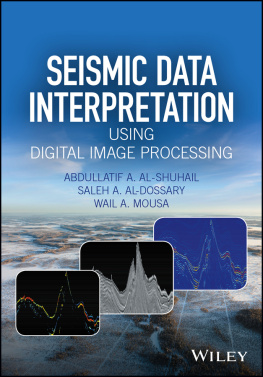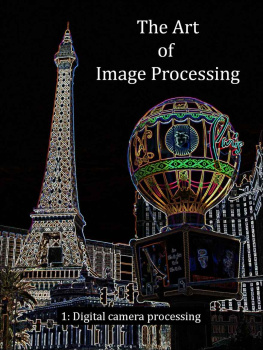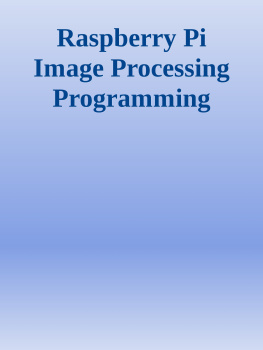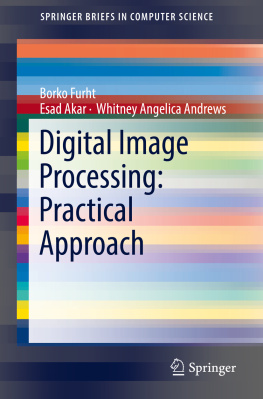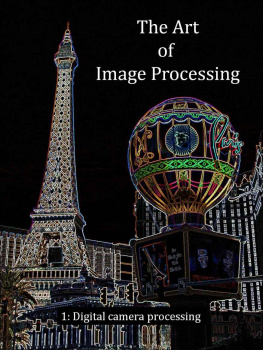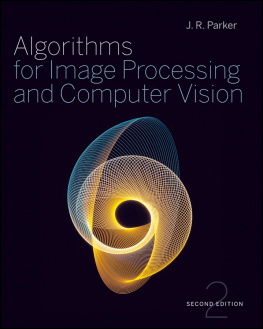Al-Shuhail Abdullatif A. - Seismic Data Interpretation Using Digital Image Processing
Here you can read online Al-Shuhail Abdullatif A. - Seismic Data Interpretation Using Digital Image Processing full text of the book (entire story) in english for free. Download pdf and epub, get meaning, cover and reviews about this ebook. year: 2017, publisher: John Wiley & Sons, Incorporated, genre: Home and family. Description of the work, (preface) as well as reviews are available. Best literature library LitArk.com created for fans of good reading and offers a wide selection of genres:
Romance novel
Science fiction
Adventure
Detective
Science
History
Home and family
Prose
Art
Politics
Computer
Non-fiction
Religion
Business
Children
Humor
Choose a favorite category and find really read worthwhile books. Enjoy immersion in the world of imagination, feel the emotions of the characters or learn something new for yourself, make an fascinating discovery.
- Book:Seismic Data Interpretation Using Digital Image Processing
- Author:
- Publisher:John Wiley & Sons, Incorporated
- Genre:
- Year:2017
- Rating:4 / 5
- Favourites:Add to favourites
- Your mark:
- 80
- 1
- 2
- 3
- 4
- 5
Seismic Data Interpretation Using Digital Image Processing: summary, description and annotation
We offer to read an annotation, description, summary or preface (depends on what the author of the book "Seismic Data Interpretation Using Digital Image Processing" wrote himself). If you haven't found the necessary information about the book — write in the comments, we will try to find it.
Seismic Data Interpretation Using Digital Image Processing — read online for free the complete book (whole text) full work
Below is the text of the book, divided by pages. System saving the place of the last page read, allows you to conveniently read the book "Seismic Data Interpretation Using Digital Image Processing" online for free, without having to search again every time where you left off. Put a bookmark, and you can go to the page where you finished reading at any time.
Font size:
Interval:
Bookmark:

This edition first published 2017
2017 John Wiley & Sons Ltd
All rights reserved. No part of this publication may be reproduced, stored in a retrieval system, or transmitted, in any form or by any means, electronic, mechanical, photocopying, recording or otherwise, except as permitted by law. Advice on how to obtain permission to reuse material from this title is available at http://www.wiley.com/go/permissions.
The right of Abdullatif A. Al-Shuhail, Saleh A. Al-Dossary and Wail A. Mousa to be identified as the author(s) of this work have been asserted in accordance with law.
Registered Offices
John Wiley & Sons, Inc., 111 River Street, Hoboken, NJ 07030, USA
John Wiley & Sons Ltd, The Atrium, Southern Gate, Chichester, West Sussex, PO19 8SQ, UK
Editorial Office
The Atrium, Southern Gate, Chichester, West Sussex, PO19 8SQ, UK
For details of our global editorial offices, customer services, and more information about Wiley products visit us at www.wiley.com.
Wiley also publishes its books in a variety of electronic formats and by print-on-demand. Some content that appears in standard print versions of this book may not be available in other formats.
Limit of Liability/Disclaimer of Warranty
While the publisher and authors have used their best efforts in preparing this work, they make no representations or warranties with respect to the accuracy or completeness of the contents of this work and specifically disclaim all warranties, including without limitation any implied warranties of merchantability or fitness for a particular purpose. No warranty may be created or extended by sales representatives, written sales materials or promotional statements for this work. The fact that an organization, website, or product is referred to in this work as a citation and/or potential source of further information does not mean that the publisher and authors endorse the information or services the organization, website, or product may provide or recommendations it may make. This work is sold with the understanding that the publisher is not engaged in rendering professional services. The advice and strategies contained herein may not be suitable for your situation. You should consult with a specialist where appropriate. Further, readers should be aware that websites listed in this work may have changed or disappeared between when this work was written and when it is read. Neither the publisher nor authors shall be liable for any loss of profit or any other commercial damages, including but not limited to special, incidental, consequential, or other damages.
Library of Congress Cataloging-in-Publication Data
Names: Al-Shuhail, Abdullatif Abdulrahman, 1962- author. | Al-Dossary, Saleh A., 1965- author. | Mousa, Wail Abdul-Hakim, author.
Title: Seismic data interpretation using digital image processing / Abdullatif A. Al-Shuhail, Saleh A. Al-Dossary, Wail A. Mousa.
Description: Hoboken, NJ, USA : John Wiley & Sons Inc., 2017. | Includes bibliographical references and index.
Identifiers: LCCN 2017005390 (print) | LCCN 2017008974 (ebook) | ISBN 9781118881781 (hardback) | ISBN 9781118881804 (Adobe PDF) | ISBN 9781118881798 (ePub)
Subjects: LCSH: Seismic reflection method. | Image processing-Digital techniques. | Petroleum-Prospecting-Data processing.
Classification: LCC TN269.84 .A425 2017 (print) | LCC TN269.84 (ebook) | DDC 551.22028/7-dc23
LC record available at https://lccn.loc.gov/2017005390
Cover Design: Wiley
Cover Image: (Background) Artpilot/Gettyimages; (Inset Images) Courtesy of authors
To my dear parents and family. AAS
To anyone who has ever taught me something. SAD
To my beloved father, mother, wife, and children. To KFUPM and my country. WAM
Human beings are experts at pattern recognition. We are well equipped to find a missing set of keys in a cluttered drawer, to find a family member in a crowd, to find the image of a cow in the clouds, or to find a mythological character in a constellation of stars. Such pattern recognition is key to seismic data analysis, where a human interpreter identifies and integrates the amplitude, spectral content, waveform, and geometric configuration of the seismic response to the underlying geology with an appropriate tectonic, depositional, or diagenetic model. For a seasoned interpreter, much of this pattern recognition is done subconsciously, requiring little conscious thought, much like pedaling and maintaining your balance on a bicycle. However, advances in seismic acquisition and processing technology are increasing more rapidly than the number of seismic interpreters. Some modern seismic surveys may be 100 Gbytes in size, while merged surveys may be larger still. It has become increasingly intractable for an interpreter to examine each and every seismic voxel.
Seismic attributes attempt to reduce the amount of data the interpreter needs to examine by capturing the same key components used in the conventional interpretation of vertical seismic amplitude sections. All attributes except the input seismic amplitude data itself implicitly or explicitly define an analysis window. Instantaneous attributes are, in reality, not instantaneous, but rather integrate the information of neighboring samples through the use of a Hilbert transform. Spectral magnitude and phase components use the information of neighboring samples on a seismic trace, while post-stack impedance inversion uses the information content of all the overlying samples as well. Geometric attributes such as coherence, curvature, and texture analysis operate in a three-dimensional (3D) window, including neighboring seismic samples and traces, often oriented along structural dip. Amplitude versus offset, inversion for P- and S-impedances, and estimates of amplitude versus azimuth increase the size of the data to be analyzed further. By extracting such key components as an auxiliary attribute volume, an experienced interpreter can now rapidly animate through time or depth slices to identify subtle, and otherwise easily overlooked, channels, mounds, collapse, slumps, faults, and folds, as well as zones of anomalous porosity or anisotropy. Equally important, other professionals, including stratigraphers, structural geologists, drilling engineers, and completion engineers, now have access to images that have removed much of the overprint of the seismic wavelet and begin to mimic interpreted geologic cross-sections and maps.
While geoscientists call such resulting images seismic attribute volumes, most of the scientific world refers to them as the results of image processing. Recent advances in medical X-ray analysis, positron emission tomographycomputed tomography scans, video images, and meteorological data have not yet been applied to 3D seismic data volumes. For example, can one apply techniques to map the corkscrew veins seen in 3D images of a human kidney to mapping crosscutting channels in a fluvial deltaic complex? Can one apply techniques used to monitor changes in land use of a suspected terrorist or narcotics site to monitor changes due to reservoir completion? Can one use techniques in Doppler radar to map tornadoes to identify potential drilling hazards seen in seismic anisotropy? While most seismic interpreters have a rudimentary understanding of human anatomy, land use, and weather, few radiologists, security analysts, and meteorologists, let alone algorithm developers with a traditional electric engineering background, have a good understanding of geology and geologic processes, let alone geology convolved with a seismic wavelet.
The authors of
Next pageFont size:
Interval:
Bookmark:
Similar books «Seismic Data Interpretation Using Digital Image Processing»
Look at similar books to Seismic Data Interpretation Using Digital Image Processing. We have selected literature similar in name and meaning in the hope of providing readers with more options to find new, interesting, not yet read works.
Discussion, reviews of the book Seismic Data Interpretation Using Digital Image Processing and just readers' own opinions. Leave your comments, write what you think about the work, its meaning or the main characters. Specify what exactly you liked and what you didn't like, and why you think so.

